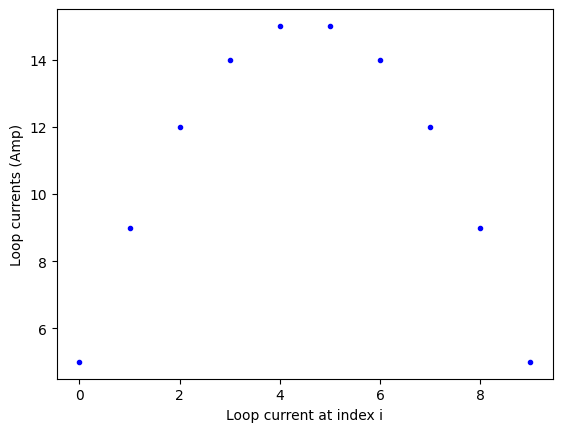Linear Systems of Equations#
import numpy as np
import scipy.linalg as la
import matplotlib.pyplot as plt
Solve linear systems of equations \(A \mathbf{x} = \mathbf{b}\):
Create NumPy arrays to represent \(A\) and \(\mathbf{b}\)
Compute the solution \(\boldsymbol{x}\) using the SciPy function
scipy.linalg.solve
Learn about NumPy arrays and the SciPy Linear Algebra package.
Example: Solve \(A \mathbf{x} = \mathbf{b}\) with scipy.linalg.solve#
Compute the solution of the system \(A \mathbf{x} = \mathbf{b}\) where
A = np.array([[2,1,1],[2,0,2],[4,3,4]])
b = np.array([[-1],[1],[1]])
print(A)
[[2 1 1]
[2 0 2]
[4 3 4]]
print(b)
[[-1]
[ 1]
[ 1]]
type(b)
numpy.ndarray
x = la.solve(A,b)
print(x)
[[-1.16666667]
[-0.33333333]
[ 1.66666667]]
Due to rounding errors in the computation, our solution \(\hat{\mathbf{x}}\) is an approximation of the exact solution
Compute the norm of the residual \(\| \mathbf{b} - A \mathbf{x} \|\)
r = la.norm(b - A @ x)
print(r)
2.220446049250313e-16
Example: Resistor Network#
Compute the solution of the system \(A \mathbf{x} = \mathbf{b}\) for
where \(A\) is a square matrix of size \(N\), and \(R\) and \(V\) are some positive constants. The system is a mathematical model of the parallel circuilt

such that the solution consists of the loops currents \(i_1,\dots,i_N\).
N = 10
R = 1
V = 1
A1 = 2*R*np.eye(N)
A2 = np.diag(-R*np.ones(N-1),1)
A = A1 + A2 + A2.T
b = V*np.ones([N,1])
print(A)
[[ 2. -1. 0. 0. 0. 0. 0. 0. 0. 0.]
[-1. 2. -1. 0. 0. 0. 0. 0. 0. 0.]
[ 0. -1. 2. -1. 0. 0. 0. 0. 0. 0.]
[ 0. 0. -1. 2. -1. 0. 0. 0. 0. 0.]
[ 0. 0. 0. -1. 2. -1. 0. 0. 0. 0.]
[ 0. 0. 0. 0. -1. 2. -1. 0. 0. 0.]
[ 0. 0. 0. 0. 0. -1. 2. -1. 0. 0.]
[ 0. 0. 0. 0. 0. 0. -1. 2. -1. 0.]
[ 0. 0. 0. 0. 0. 0. 0. -1. 2. -1.]
[ 0. 0. 0. 0. 0. 0. 0. 0. -1. 2.]]
print(b)
[[1.]
[1.]
[1.]
[1.]
[1.]
[1.]
[1.]
[1.]
[1.]
[1.]]
x = la.solve(A,b)
plt.plot(x,'b.')
plt.xlabel('Loop current at index i')
plt.ylabel('Loop currents (Amp)')
plt.show()

print(x)
[[ 5.]
[ 9.]
[12.]
[14.]
[15.]
[15.]
[14.]
[12.]
[ 9.]
[ 5.]]

